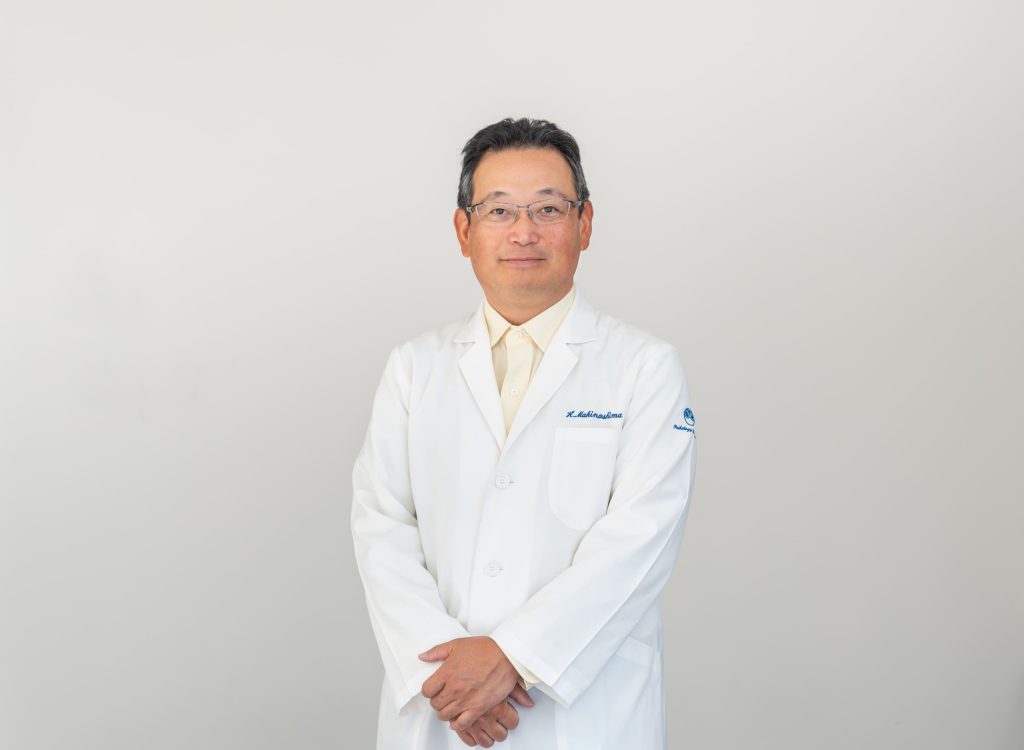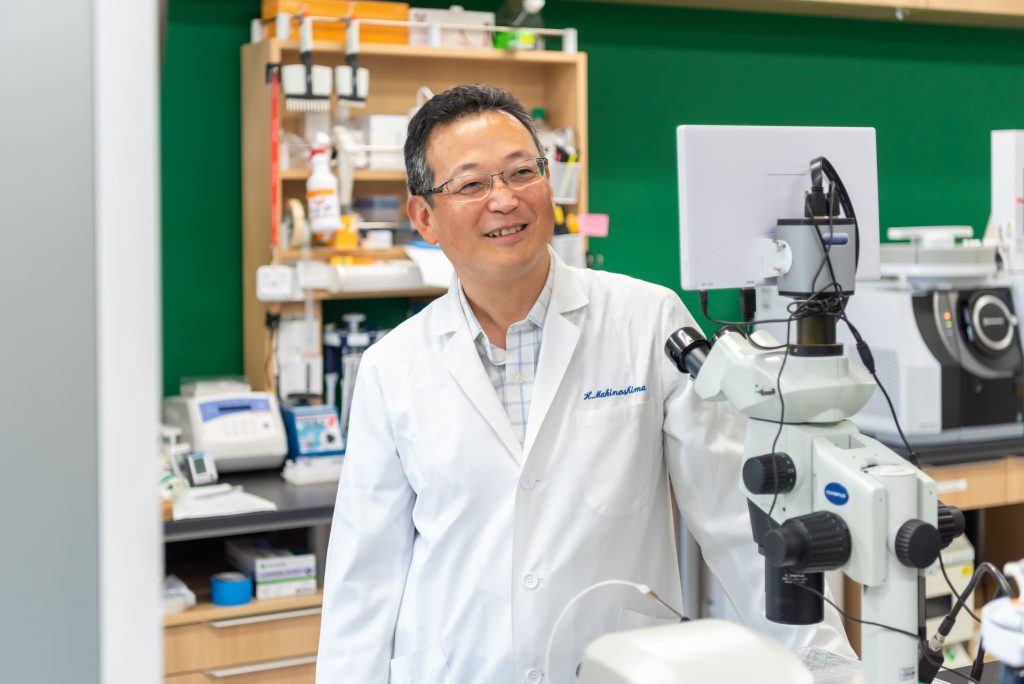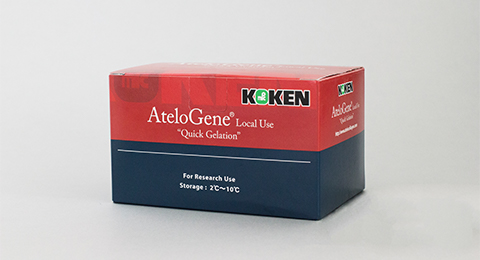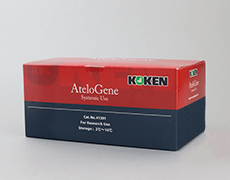Resources
Categories
Researcher Interview: Sustained-release transfection reagent, AteloGene®

Dr. Hideki Makinoshima, the team leader of the Cancer Metabolomics Laboratory at the National Cancer Center Tsuruoka Collaborative Research Center
To develop new treatments by investigating cancer-specific metabolic pathways and metabolites.
Cancer research is a critical concern because one in two people in Japan are affected by cancer. Research is currently underway from various perspectives to elucidate the mechanisms of carcinogenesis, prevent cancer, and develop new treatments. Dr. Hideki Makinoshima, the team leader of the Cancer Metabolomics Laboratory at the National Cancer Center Tsuruoka Collaborative Research Center, which conducts cancer metabolism research, is involved in the discovery of cancer-specific metabolic pathways and drugs that inhibit cancer metabolism.
In a study on small-cell lung cancer that was published in June 2021, he elucidated the function of RRM1 by suppressing the expression of the RRM1 gene, a subunit of ribonucleotide reductase (RNR), using small interfering RNA (siRNA). It has been elucidated that the dysfunction of RNR reduces the cell proliferation of small-cell lung cancer in culture vessels and tumorigenicity of small-cell lung cancer in vivo. Furthermore, it induces a DNA damage response and arrests the cell cycle, which is controlled by RNR. It is hoped that this will lead to the development of new treatments targeting cancer nucleic acid metabolic pathways.
For RNA interference using siRNA, Dr. Makinoshima utilized AteloGene® Local Use “Quick Gelation,” a sustained release in vivo siRNA/mRNA introduction kit from Koken Co., Ltd. The effect of suppressing gene expression using siRNA is temporary and limited. However, the use of AteloGene®, which can continuously introduce siRNA, in the experiment enabled the observation of the suppression effects over several weeks, leading to successful results. We spoke to Dr. Makinoshima about metabolic research and its significance in the field of cancer research.
To elucidate the nucleic acid metabolic pathway of cancer
| What is the role of metabolic research in the cancer field? |
Our research has two main objectives. The first is a comprehensive metabolome analysis of patient-derived clinical specimens stored at the National Cancer Center and the construction of metabolite profiles. The second is research that uses model systems to elucidate the metabolic control mechanisms such as biosynthesis, degradation, and recycling of nucleic acids. By targeting cancer-specific metabolism, it is possible to develop blockbuster drugs that can be applied to various cancer types. Drugs that target metabolism include folate antimetabolites and IDH inhibitors, which have been used since the 1940s, but they have side effects because normal cells have similar folate metabolic pathways that are also affected. In addition, the evaluation of metabolites has the disadvantage of being highly variable depending on the state of the body, which makes it difficult to translate this into clinical application.
| But it is important to focus on metabolism, right? |
What is interesting about metabolic research is that when you add a drug to a series of chemical reactions, or metabolic pathways, you can observe the effects. Drug X, which inhibits A→B, is effective against the entire metabolic pathway of A→B→C→D, but when C is added, the effect may be lost. However, what is important is what happens to the effect of X when the final metabolite D is added, and if there is a change, we know that X inhibits the A→D reaction, and C and D can be used as biomarkers. Metabolism is particularly important in anticancer drug research because changes in the amount of metabolites change the drug sensitivity and enable the identification of biomarkers. Eventually, metabolite biomarkers will help identify patients for whom the drugs are effective and lead to the development of new drugs and treatments with fewer side effects.

Suppressing enzyme gene expression by continuously introducing siRNA
| In your paper on enzymes important for DNA nucleotide biosynthesis in lung cancer, you used AteloGene® Local Use “Quick Gelation,” a sustained release in vivo siRNA/mRNA introduction kit from Koken. How was it used? |
In collaboration with Keio University’s Institute of Advanced Biosciences (IAB), we used siRNA to suppress the expression of RRM1, an RNR subunit, in small-cell lung cancer cell lines and elucidate the function of RRM1.
|
De novo deoxyribonucleotide biosynthesis regulates cell growth and tumor progression in small-cell lung carcinoma.
Maruyama A, Sato Y, Nakayama J, Murai J, Ishikawa T, Soga T, Makinoshima H. Sci Rep. 2021 Jun 29;11(1):13474. PMID: 34188151. |
AteloGene® was used to demonstrate the function of the enzymes involved in nucleic acid biosynthesis by suppressing gene expression in a mouse xenograft model. There are three possible methods to suppress gene expression in a xenograft model: (1) temporary gene knockdown using siRNA; (2) sustained gene knockdown using short hairpin (shRNA); and (3) gene knockout using CRISPR-Cas9. The RRM1 gene, which we focused on in the nucleic acid biosynthesis pathway, is essential for the survival of small-cell lung cancer cells. Therefore, it was assumed that it would be challenging to establish an experimental system for methods (2) and (3); therefore, we used method (1). However, siRNA has the disadvantage that the effective time after introduction is short, and the effect is only temporary. Therefore, we needed a method that could continuously transfect; therefore, we decided to combine siRNA and AteloGene® and inject it subcutaneously into mice once every 3 to 4 days. Through the slow release of the siRNA from AteloGene®, which gels and envelops the subcutaneous tumor after administration and introduces it into cancer cells, we were able to maintain a suppressed state of gene expression for several weeks. AteloGene®’s main component, atelocollagen, and the siRNA form a complex that prevents degradation, and AteloGene® acts as a support, which allows for the sustained release of siRNA to the target areas. Preparation was very simple, and only required the mixing of each liquid. As a result, in the group wherein the RRM1 gene was knocked down, the tumorigenicity of small-cell lung cancer was reduced, the DNA damage response was induced, the cell cycle was arrested, and metabolites that were regulated by RNR were revealed.

An example of administering RRM1 siRNA to a small-cell lung cancer subcutaneous tumor model mouse using AteloGene®. Reference:Sci Rep 11, 13474 (2021). Created by modifying figure 3. ©Makinoshima H., et al. 2021 (Licensed under CC BY 4.0)
| How did you feel after using AteloGene® Local Use “Quick Gelation”? |
AteloGene® is very easy to use because it can be controlled using temperature. It maintains a liquid state when chilled at 4°C and solidifies into a gel at 37°C; therefore, it quickly forms a gel when administered subcutaneously into the mice. Our experimenter said that while it is easy to prepare by simply combining it with the siRNA, there is some loss as it sticks to tubes. When she tried to collect it, a lot of air bubbles were generated, and it took a long time to remove them; therefore, it might be easier to handle if the viscosity was a little lower.
In addition, although this is not limited to AteloGene®, we also found that siRNA is less effective against large tumors. If it is effective only when the tumor is small, it can only be used during early detection, which is difficult when considering the clinical application. I believe that if we could similarly envelop larger tumors and introduce siRNA into them, this could also be used as a drug delivery system for oligonucleotide drugs.
| What led you to adopt AteloGene® Local Use “Quick Gelation”? |
I had already heard about Koken’s collagen products for cell culture applications. In addition, AteloGene® was developed through joint research by Dr. Takahiro Ochiya from the National Cancer Center (currently at Tokyo Medical University School of Medicine) and Koken. Our National Cancer Center Tsuruoka Collaborative Research Center is encouraged by the government to conduct joint research projects with companies in Yamagata Prefecture, which is when we learned that Koken’s production base was located here. Because this is a tax-funded project, I wanted to use domestically produced equipment and reagents; therefore, I definitely wanted to make use of their products. AteloGene® is a product that has already produced many research results; therefore, I felt confident using it.
AteloGene®Local Use “Quick Gelation”
Fascinated by the mysteries of genes, he became a researcher
| How did Dr. Makinoshima pursue his career as a researcher? |
I have wanted to become a researcher since high school. I did not study much, but I found biology very interesting. I became interested in genes and genetic engineering and studied molecular biology at university. However, I bought books and read them on my own rather than in class. I feel like this self-study has made me who I am today.
| Why did you become interested in genes? |
Partly because biotechnology was at the forefront of scientific breakthroughs, but I was also very curious. When it came to innovative science, I could probably have chosen the computer field at the time, but I was always interested in the obscure and mysterious aspects of living things. It was strange to begin with the fact that the genetic information in DNA is made up of a combination of four types of nucleotides (ATGC), and this is still a mystery to this day. There was a time when it was said that if we understood the human genome, all mysteries could be solved, but in the end, most things remain unsolved. Even if we have more information, it does not mean we necessarily get closer to solving the mysteries, and it feels even more profound. Cancer research may be solved if we have more information, such as gene sequences, RNA gene expression, proteins, and metabolomes, but even if we have greater knowledge, I believe that we are still far from the essence of what cancer is. You could say that it is the unknown that makes research so interesting.
Metabolic research provides seeds that will change treatment policies in 10 years
| From biology to cancer research, why did you choose metabolic research? |
I studied molecular biology and biochemistry, and studying abroad at the New York Memorial Sloan-Kettering Cancer Center in the United States had a significant impact on me. At the time, I was researching infectious diseases caused by bacteria; however, as I watched and listened to cancer research being done around me, I became interested in it. Bacterial infections are still a serious problem in developing countries, but in Japan, there are more people dying of cancer. I also lost my father to hepatocellular carcinoma. The disease progressed from hepatitis C to liver cirrhosis and then to hepatocellular carcinoma, similar to an equation, and my family suffered through a long battle with the disease; therefore, I wanted my research to be of some help and importance. Thanks to advances in medicine, more new treatments are now available. We are now in an era where hepatitis C is curable; therefore, I feel the importance of making progress.
My interest in metabolic research began when Dr. Hiroyasu Esumi was assigned as my mentor at the National Cancer Center Hospital East. Being there and watching my mentor work hard had a profound impact on me. Currently, I enjoy working with young researchers and seeing them excitedly present their results and discuss them. The performance of mass spectrometers has improved year by year, which has increased the number and amount of metabolites that can be detected, although currently there is a limit to the ability to measure only 150–200 low-molecular-weight substances in human samples. It is a field of research where there are still many unknowns, such as how many substances exist in cells, including those that cannot be measured, and whether there are unknown metabolic pathways and reactions. This is what makes it interesting but also challenging.

| Please tell us about your outlook on your research. |
The major goal is to eradicate cancer and reduce the burden on patients. Considering the compatibility of metabolic research with cancer research, there is also a research field for the prevention of cancer by controlling nutrition and improving diet. If interventions such as preoperative nutritional improvement can be shown to be effective by measuring the metabolites, this will lead to an improved quality of life for patients undergoing surgery whose prognosis is predicted to be poor. Regarding research into new treatments, there is a strong tendency to believe that it is dangerous to use nucleic acids in clinical practice, but the introduction of mRNA vaccines for COVID-19 saw it gain some acceptance, and this has provided an opportunity for research using nucleic acids and oligonucleotide drugs. I hope that this development will progress further.
| Please provide a message to young researchers and those who are aiming to pursue careers in cancer or metabolism research. |
It is not uncommon for cancer to affect you or someone close to you; therefore, I would like to invite you to join us in research that will help eradicate this serious disease and help patients. As I mentioned earlier, there are many challenging aspects of metabolic research, but our job is to prove that quantitative analysis and measurement are necessary. Metabolome analysis provides insight into multiple metabolites in addition to conventional biochemical tests. The test items for biochemical tests in the medical field have barely changed, but in 10 years, items that are commonly required may be added, and we may reach an era when 100–200 items can be assessed from a single drop of blood. In the field of cancer, screening and treating genetic mutations would have been unimaginable 10 years ago, but they are now being used clinically. Similarly, it can lead to research that will change treatment policies in 10 years. Therefore, I would like to encourage young researchers to start researching metabolism.
(This article is a reprinted advertorial published on Research-er.jp)



